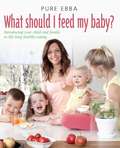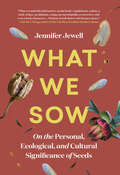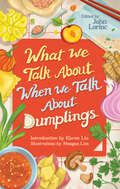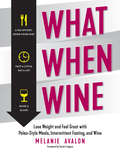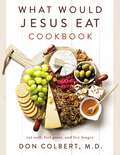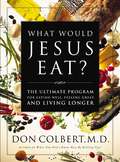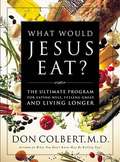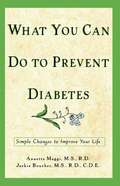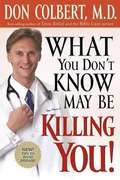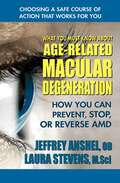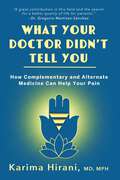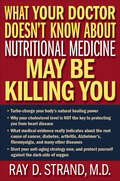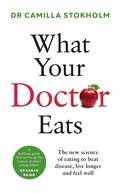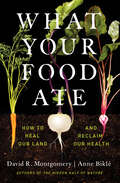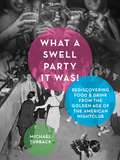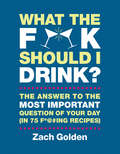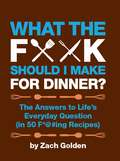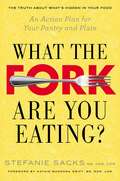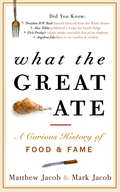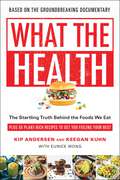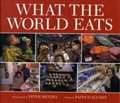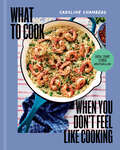- Table View
- List View
What Should I Feed My Baby: Introducing Your Child To Life-long Healthy Eating
by Pure EbbaWhat should I feed my baby? is a simple but thorough guide for parents who want to introduce their baby to wholesome and nutritious food right from the start. Even if you are not skilled in the kitchen you will learn how to cook fresh and natural food so that you know your baby is receiving only the healthiest foods. This book takes a parent from baby's first taste of solid food at around 4/6 to 12 months and beyond, and includes: A detailed list of organic and superfoods that your baby can eat at particular ages; Guidelines on fruit, vegetables, seeds, whole grains, nuts and superfoods; Simple recipes for babies and young children; Healthy recipes for the whole family to enjoy together; Healthy and delicious recipes for special occasions, such as baby's birthday! Ebba sees herself as a new Annabel Karmel, but with a stronger focus on introducing superfoods to your baby at the weaning stage so that they become part of their everyday diet. This book is not just about what your baby can eat at different stages but about what are the best and most nutritional foods for them to eat in order to develop into healthy and strong children.
What Was It Before It Was Bread?
by Jane Belk MoncureTraces the process by which wheat is grown, cut, ground into different kinds of flour, and baked into bread. Includes a recipe for whole wheat muffins.
What Was It Before It Was Ice Cream?
by Colleen Reece Jane BuergerHow is ice cream made and what goes into making ice cream? How can you make ice cream at home? Find out in this book with a recipe for ice cream.
What We Sow: On the Personal, Ecological, and Cultural Significance of Seeds
by Jennifer JewellAn insightful, personal, and timely exploration into the wonderful world of seeds. In What We Sow, Jennifer Jewell brings readers on an insightful, year-long journey exploring the outsize impact one of nature's smallest manifestations—the simple seed. She examines our skewed notions where "organic" seeds are grown and sourced, reveals how giant multinational agribusiness has refined and patented the genomes of seeds we rely on for staples like corn and soy, and highlights the efforts of activists working to regain legal access to heirloom seeds that were stolen from Indigenous peoples and people of color. Throughout, readers are invited to share Jewell's personal observations as she marvels at the glory of nature in her Northern California hometown. She admires at the wild seeds she encounters on her short daily walks and is amazed at the range of seed forms, from cups and saucers to vases, candelabras, ocean-going vessels, and airliners. What We Sow is a tale of what we choose to see and what we haven't been taught to see, what we choose to seed and what we choose not to seed. It urgently proves that we must work hard to preserve and protect the great natural diversity of seed.
What We Talk About When We Talk About Dumplings
by John LorincNearly every culture has a variation on the dumpling: histories, treatises, family legends, and recipes about the world’s favourite lump of carbs If the world's cuisines share one common food, it might be the dumpling, a dish that can be found on every continent and in every culinary tradition, from Asia to Central Europe to Latin America. Originally from China, they evolved into ravioli, samosas, momos, gyozas, tamales, pierogies, matzo balls, wontons, empanadas, potato chops, and many more. In this unique anthology, food writers, journalists, culinary historians, and musicians share histories of their culture’s version of the dumpling, family dumpling lore, interesting encounters with these little delights, and even recipes to unwrap the magic of the world's favourite dish. With an introduction by Karon Liu. Illustrations by Meegan Lim. Contributors include: Michal Stein, Christina Gonzales, Kristen Arnett, David Buchbinder, André Alexis, Miles Morrisseau, Angela Misri, Perry King, Sylvia Putz, Mekhala Chaubal, Arlene Chan, Chantal Braganza, Naomi Duguid, Eric Geringas, Matthew Murtagh-Wu, Monika Warzecha, Bev Katz Rosenbaum, Tatum Taylor Chaubal, Domenica Marchetti, Julie Van Rosendaal, Amy Rosen, Cheryl Thompson, Jennifer Jordan, Marie Campbell, Navneet Alang
What When Wine: Lose Weight And Feel Great With Paleo-style Meals, Intermittent Fasting, And Wine
by Melanie Avalon Sarah FragosoAn effortless—really!—approach that turns the body into a fat-burning machine. Is it possible to eat well, drink wine, and still lose weight? Melanie Avalon is living proof that, heck yeah, it’s not only possible, it’s unbelievably simple and straightforward. It’s all about the what (mostly Paleo, but she’s not a monster about it), the when (believe it or not, brief fasting can mean freedom rather than restriction), and the wine (red wine can be a secret bullet for weight loss—who knew?). It’s a combination that Avalon discovered after years of self-experimentation and intense research on the mechanics of body fat regulation. In What When Wine, Avalon shares her journey to a healthier lifestyle, with the tips and tricks she learned along the way, as well as a jumpstart plan including 50 delicious Paleo-friendly, gluten-free recipes by chef Ariane Resnick.
What Would Brian Boitano Make?: Fresh and Fun Recipes for Sharing with Family and Friends
by Brian BoitanoBrian Boitano has traveled all over the world for skating competitions, and he is fascinated with other cultures and their cuisine. He now finds the same deep fulfillment in cooking and entertaining that he once found in skating. His adventures abroad influence his own style of cooking, as does his Italian heritage, where great food has always been a key part of any gathering. Some of Boitano’s favorite food memories revolve around family get-togethers, and his cookbook includes personal vignettes and dishes that are inspired by memorable family recipes.The recipes in What Would Brian Boitano Make? emphasize taste, convenience, and nutrition. Boitano pairs intriguing flavors and textures, playing with the balance of opposites to add complexity to his recipes. While gourmet in taste, the ingredients are easily accessible to any home cook. Mouthwatering recipes include: Paella Sliders, Crab-and-Avocado Crostini, Blood Orange Mojito, Butternut Squash Soup with Goat Cheese Toasts, Heirloom Tomato Cantaloupe and Feta Salad, Summer Squash Risotto with Grilled Lemon Basil Chicken, Pork Tenderloin with Warm Plum Salsa, Salmon with Pea and Basil Pesto, and Coconut Flan.
What Would Jesus Eat Cookbook
by Don ColbertIf you want to live a healthier lifestyle that aligns with your faith, the What Would Jesus Eat Cookbook is a resource that provides more than 90 nutritional recipes and life-changing information to help you improve your health. This is not just a cookbook; it&’s a health resource you&’ll use all year.This renewed edition of the What Would Jesus Eat Cookbook is a compilation that features content and recipes from What Would Jesus Eat? along with comprehensive updates based on new studies and data within the health industry.Inside you&’ll find:more than 90 simple yet healthy recipes that anyone can make.key takeaways at the end of each chapter that provide answers to frequently asked questions.information about anxiety, autoimmune disorders, cancer, diabetes, fatigue, food allergies, inflammation, insomnia, Lyme disease, memory loss, migraines, thyroid disease, and weight loss.helpful advice to help you choose organic options and eat clean.tips on freezing foods, baking pan suggestions based on cups/servings, and emergency ingredient substitution suggestions.Dr. Colbert has been a board-certified family practice doctor for more than 25 years. He is also board-certified through the American Academy of Anti-Aging Medicine and has received extensive training in nutritional and preventative medicine. What Would Jesus Eat Cookbook presents "the Jesus way of eating." If you truly want to follow Jesus in every area of your life. you cannot ignore your eating habits. Are you willing to make a commitment to follow Jesus' example and eat the way He ate?
What Would Jesus Eat?: The Ultimate Program For Eating Well, Feeling Great, And Living Longer
by Don ColbertThough there are many diet programs claiming to be "God's way" to healthy living, and while some of them are based on biblical principles, and even have proven effective for weight loss, What Would Jesus Eat? is the first to note the obvious health benefits of what Jesus ate. In this comprehensive program, Dr. Don Colbert reveals the sensible approach to healthy eating laid out by the ultimate role model. Readers will discover:Why foods forbidden in the Old Testament are unhealthyJesus's favorite foods, including "fast foods" and dessertThe health benefits of foods Jesus ate, and the health risks of foods He avoidedAlso included are Dr. Colbert's tools to effectively follow the plan: recipes, nutritional information, and practical advice, including how to follow Jesus's model of eating with foods readily available today.
What Would Jesus Eat?: The Ultimate Program for Eating Well, Feeling Great, and Living Longer
by Don ColbertDoes Scripture teach us how to live and eat? Based on medical and historical research, this health specialist says yes! Dr. Colbert shows you why those foods Jesus ate are ideal for 21st-century living---and why those he avoided continue to pose health risks. Discover a comprehensive nutrition plan that incorporates Bible-based eating.
What You Can Do To Prevent Diabetes
by Annette Maggi Jackie BoucherThis is composed of eight parts, in them you will find among other things, a simple changes journal, and realistic examples of how the plan they outline can be applied to every-day life.
What You Don't Know May Be Killing You
by Don ColbertYou know that proper diet, exercise, and rest can keep you in good health, but perhaps you wonder if you're doing enough. Perhaps you've seen family members and friends who took care of themselves devastated by illness. Was there something they could have done to prevent the disease or illness. The truth is...what you don't know may be killing you. Dr. Don Colbert's answers and updated information may surprise you AND help you!
What You Must Know About Age-Related Macular Degeneration
by Jeffrey Anshel Laura Stevens, MSciAge-related macular degeneration—AMD—is the most commonly diagnosed eye disorder in people over fifty. Well over two million Americans have been told they have AMD, and that number is expected to grow substantially. While this is a frightening statistic, over the last several years, medical researchers have shown that a number of effective treatments can slow, stop, and even reverse the progress of AMD. Now, best-selling authors Dr. Jeffrey Anshel and Laura Stevens, who herself has been diagnosed with this condition, have joined forces to produce an up-to-date guide to what you need to know to combat and even prevent AMD. The book is divided into four parts. Part One explains how the eye works and how AMD develops, in both its wet and its dry forms. It then looks at the most common risk factors and explains how each of these factors negatively affects the structures of the eye. In Part Two, the authors look at the specific nutrients that affect the various cells of the eye. Included is a discussion of AREDS—the National Eye Institute&’s study that showed which supplements help protect the eye from disease. Part Three offers an additional weapon against AMD. It explains why diet matters and offers advice on selecting foods that promote eye health while eliminating those that do the most damage. Part Four provides practical suggestions and easy-to-follow tips on how to incorporate this valuable information into your life.If AMD runs in your family or you have been diagnosed with this potentially life-altering condition, it is important to know that there is not only hope, but a real path to a better, healthier life. Knowledge is power, and the more you know, the more likely you are to avoid the consequences of AMD. Let What You Must Know About Age-Related Macular Degeneration help you safeguard one of your most precious gifts—eyesight.
What Your Doctor Didn't Tell You: How Complementary and Alternative Medicine Can Help Your Pain
by Dr. Karima HiraniHelp with your pain is within reach! Let Dr. Karima Hirani teach you the most advanced therapies from alternative and complementary medicine for your pain.One in five American adults suffer from chronic pain and it affects over a billion people globally. While consumers spend billions of dollars on over-the-counter and prescription remedies, the usual outcomes of standard pain management are dismal. So, why are pain sufferers told so often that they need to live with their pain? Pain can impact every aspect of our lives from overall wellbeing and psychological health to economic and social welfare. Anxiety, depression, insomnia, and stress are four of the most common symptoms that accompany chronic pain—but all are actually treatable. For decades, Dr. Karima Hirani achieved successful treatment for thousands of pain sufferers. What Your Doctor Didn&’t Tell You: How Complementary and Alternative Medicine Can Help Your Pain offers readers a less invasive, natural, integrative approach that can finally provide them with relief. Combining the most advanced therapies from alternative and complementary medicine, her book shows how pain sufferers can improve their quality of life, performance, and prevention—and much more including: How Mother Nature&’s pulsed electromagnetic fields work to resolve pain;The secret treatment which helped President Kennedy with his chronic back pain that you can also use;How Oxygen-ozone therapy succeeds when other pain treatments fail;How to manage your gut-brain axis to control inflammation and pain;How the allergy elimination diet with exercise can bring about a 25 - 30 percent improvement of pain; andThat not all knee pain is osteoarthritis, so you may not need that knee replacement.As Dr. Hirani says, "You don't need to let another day go by with pain!"
What Your Doctor Doesn't Know About Nutritional Medicine May Be Killing You
by Ray D. StrandWhen Dr. Ray Strand found himself in a losing battle, unable to successfully treat his wife who had suffered chronically with pain and fatigue, he agreed to try the regimen of nutritional supplements that a neighbor suggested. Much to his surprise, his wife's condition began to improve almost immediately. That amazing turn of events led him to dedicate himself to researching alternative therapies in medicine, particularly in the arena of nutritional supplements. Dr. Strand's illumination of the body's silent enemy-oxidative stress-will astound you. But, more importantly, his research will equip you to protect or reclaim your nutritional health, possibly reversing disease and preventing illness.
What Your Doctor Eats
by Dr Camilla Stokholm'What Your Doctor Eats is a marvellous fact-filled journey of discovery that everyone can learn from and enjoy.' – Tim SpectorWhen Dr Camilla Stokholm started work as a GP, her health unravelled; she rapidly gained weight, felt exhausted and had debilitating IBS. Determined to find out the root cause, she discovered that what she ate each day played a much bigger role in her well-being than she ever thought possible.What Your Doctor Eats is everything Dr Stokholm has learnt in her journey back to health. Using the tools in this book – including easy ways to boost the gut microbiome, tips to stabilise hormones and hacks to make sustainable change – she transformed her own health and that of her patients, and now you can too.With a mixture of myth-busting facts, a look at the role of our genes and diet culture, along with the latest discoveries in nutrition science and with a delicious recipe section, this book is the only book you need to feel at your very best.
What Your Food Ate: How to Heal Our Land and Reclaim Our Health
by David R. Montgomery Anne BikléAre you really what you eat? David R. Montgomery and Anne Biklé take us far beyond the well-worn adage to deliver a new truth: the roots of good health start on farms. What Your Food Ate marshals evidence from recent and forgotten science to illustrate how the health of the soil ripples through to that of crops, livestock, and ultimately us. The long-running partnerships through which crops and soil life nourish one another suffuse plant and animal foods in the human diet with an array of compounds and nutrients our bodies need to protect us from pathogens and chronic ailments. Unfortunately, conventional agricultural practices unravel these vital partnerships and thereby undercut our well-being. Can farmers and ranchers produce enough nutrient-dense food to feed us all? Can we have quality and quantity? With their trademark thoroughness and knack for integrating information across numerous scientific fields, Montgomery and Biklé chart the way forward. Navigating discoveries and epiphanies about the world beneath our feet, they reveal why regenerative farming practices hold the key to healing sick soil and untapped potential for improving human health. Humanity’s hallmark endeavors of agriculture and medicine emerged from our understanding of the natural world—and still depend on it. Montgomery and Biklé eloquently update this fundamental reality and show us why what’s good for the land is good for us, too. What Your Food Ate is a must-read for farmers, eaters, chefs, doctors, and anyone concerned with reversing the modern epidemic of chronic diseases and mitigating climate change.
What a Swell Party It Was!: Rediscovering Food & Drink from the Golden Age of the American Nightclub
by Michael TurbackChef and restaurateur Daniel Boulud once explained: “The future of cooking is about how we can rewrite the history of it—it’s important to keep the memory and be entertained by it and inspired by it.” What A Swell Party It Was! entertains and inspires with a delicious slice of nearly forgotten culinary history—an era that followed the Great Depression and prohibition’s repeal, where America boomed and the nightclub scene flourished.Opening this book is like swinging open the doors to another time and place, when big city life was a unique mixture of innocence and sophistication, romance and formality. It spotlights twenty-five legendary clubs that thrived in the 1930s and ’40s, just as Jazz exploded into mainstream popularity and alcohol was no longer illegal to serve. Through these pages and recipes, enter past the proverbial velvet rope into establishments forever-immortalized, such as Chez Paree in Chicago, Café Trocadero in Hollywood, The Cocoanut Grove in Los Angeles, The Blue Room in New Orleans, and New York City’s Cotton Club. In addition to including entrée, appetizer, dessert, and cocktail recipes from their original menus, each featured venue will be introduced with vivid anecdotes and history, narrated in a breezy style and illustrated with reproductions of vintage menu covers, beverage napkins, matchbooks, postcards, and rare photos.An unabashedly joyful journey and a deeply authentic perspective on American culture in a rich, tumultuous age, What a Swell Party It Was! promises a cookbook/cocktail guide with a tip of the hat to history, crammed with details that bring life again to a fascinating American era.
What the F*@# Should I Drink?: The Answers to Life's Most Important Question of Your Day (in 75 F*@#ing Recipes) (A What The F* Book)
by Zach Golden75 hilariously profane drinking recipes with unique page prompts and humorous descriptions using easy ingredients and simple directions.
What the F*@# Should I Make for Dinner?: The Answers to Life's Everyday Question (in 50 F*@#ing Recipes) (A What The F* Book)
by Zach GoldenDonOCOt know what to make for dinner? Is every evening an occasion for duress and deliberation? No more "What the F*@# Should I Make For Dinner?" gets everyone off their a**es and in the kitchen. Derived from the incredibly popular website, whatthefuckshouldimakefordinner. com, the book functions like a ?Choose your own adventureOCO cookbook, with options on each page for another f*@#ing idea for dinner. With 50 recipes to choose from, guided by affrontingly creative navigational prompts, both meat-eaters and vegetarians can get cooking and leave their indecisive selves behind. "
What the Fork Are You Eating?
by Kathie Madonna Swift Stefanie SacksIt's labeled "natural," "grass-fed," or "free-roaming;" yet it might be anything but. It's time to find out what you're actually eating... When your groceries are labeled "low-fat," "sugar-free," and even "natural" and "antibiotic-free," it's easy to assume that you're making healthy choices. Yet even some of those seemingly wholesome offerings contain chemical preservatives, pesticides, and artificial flavors and coloring that negatively affect your health. In What the Fork Are You Eating?, a practical guide written by certified chef and nutritionist Stefanie Sacks, MS, CNS, CDN, we learn exactly what the most offensive ingredients in our food are and how we can remove (or at least minimize) them in our diets. Sacks gives us an aisle-by-aisle rundown of how to shop for healthier items and create simple, nutritious, and delicious meals, including fifty original recipes.
What the Great Ate: A Curious History of Food and Fame
by Matthew Jacob Mark JacobFor foodies and trivia lovers alike, this fun and impressively researched pop-culture history offers a sampling of the peculiar culinary habits of the famous--and often notorious--figures throughout the ages.
What the Health: The Startling Truth Behind the Foods We Eat, Plus 50 Plant-Rich Recipes to Get You Feeling Your Best
by Kip Andersen Keegan Kuhn Eunice WongThe definitive, stand-alone companion book to the acclaimed documentary—now with 50 plant-based recipes and full-color photos to help you start changing your health for the better There's something terribly broken in our industrial food, medical, and pharmaceutical systems. What's going wrong? Can we really avoid the leading causes of death just by changing our diet? Kip Andersen and Keegan Kuhn, creators of the revolutionary What the Health and the award-winning Cowspiracy documentaries, take readers on a science-based tour of the hazards posed by consuming animal products—and what happens when we stop. What the Health will guide you on an adventure through this maze of misinformation with the same fresh, engaging approach that made the documentary so popular. Journey with Andersen and Kuhn as they crisscross the country, talking to doctors, dietitians, public health advocates, whistle-blowers, and world-class athletes, to uncover the truth behind the food we eat. With the help of writer Eunice Wong, they empower eaters with knowledge about the lethal entwining of the food, medical, and pharmaceutical industries, and about the corporate web that confuses the public and keeps Americans chronically—and profitably—ill. Plus, discover 50 recipes to help you reclaim your life and health, including: Creamy Mac PB&J Smoothie Winter Lentil and Pomegranate Salad Mom's Ultimate Vegan Chili Black Bean Fudgy Brownies Baked Apple Crumble with Coconut Cream If the film was a peephole, then the book knocks down the whole door, featuring expanded interviews, extensive research, and new personal narratives. There's a health revolution brewing. What the Health is your invitation to join.
What the World Eats
by Faith D'Aluisio Peter Menzel<P>Sitting down to a daily family meal has long been a tradition for billions of people. But in every corner of the world this age-old custom is rapidly changing. From increased trade between countries to the expansion of global food corporations like Kraft and Nestle, current events are having a tremendous impact on our eating habits. Chances are your supermarket is stocking a variety of international foods, and American fast food chains like McDonald's and Kentucky Fried Chicken are popping up all over the planet. For the first time in history, more people are overfed than underfed. And while some people still have barely enough to eat, others overeat to the point of illness. <P> To find out how mealtime is changing in real homes, authors Peter Menzel and Faith D'Aluisio visited families around the world to observe and photograph what they eat during the course of one week. They joined parents while they shopped at mega grocery stores and outdoor markets, and participated in a feast where a single goat was shared among many families. They watched moms making dinner in kitchens and over cooking fires, and they sat down to eat with twenty-five families in twenty-one countries--if you're keeping track, that's about 525 meals! <P>The foods dished up ranged from hunted seal and spit-roasted guinea pig to U. N. -rationed grains and gallons of Coca-Cola. As Peter and Faith ate and talked with families, they learned firsthand about food consumption around the world and its corresponding causes and effects. The resulting family portraits offer a fascinating glimpse into the cultural similarities and differences served on dinner plates around the globe. <P>[This text is listed as an example that meets Common Core Standards in English language arts in grades 2-3 at http://www.corestandards.org.]
What to Cook When You Don't Feel Like Cooking - A Cookbook
by Caroline ChambersTHE INSTANT NEW YORK TIMES, USA TODAY, AND INDIE BESTSELLERA BON APPETIT BEST COOKBOOK OF THE YEAR • A FOOD NETWORK BEST COOKBOOK OF THE YEAR • NATIONAL POST BEST COOKBOOK OF THE YEAR • AN AOL BEST COOKBOOK OF THE YEAR • NAMED ONE OF THE BEST BOOKS TO GIFT BY THE STRATEGIST, TASTING TABLE, AND FORBESRECIPES FOR BUSY PEOPLE WHO LOVE GOOD FOODWith three little boys less than two years apart and a packed schedule as an online creator, Caroline Chambers often doesn&’t feel like cooking. Can you relate? When you just can&’t motivate yourself in the kitchen, this is the simple cookbook you should reach for. Inspired by Caro&’s wildly popular Substack newsletter of the same name, What to Cook When You Don&’t Feel Like Cooking is brimming with efficient recipes that take the guesswork out of dinner—in fact, each one is a complete meal: protein, veg, starch, done! The recipes are organized by the amount of time they take to cook, so whether you have 15 minutes to throw together Peanutty Pork and Brussels or a little bit longer to simmer Turkey Bolognese with Sneaky Veggies, dinnertime is totally doable. On top of that, Caro gives you more ways to choose, so you can search by protein (Chicken thighs waiting in the fridge? Make White Chicken Chili. Nothing but beans in the pantry? Cannellini Caprese with Burrata is it!) or mood (Tomato Farrotto is perfect for a cozy craving, and Crunchy Honey Harissa Fish Tacos are an excellent way to show off). Most importantly, these recipes include Caro&’s famously extensive swaps, riffs, tips, shortcuts, and more to be sure they work best for you, helping you save money, improvise, and even learn a thing or two. They don&’t compromise quality or flavor—and they deliver every time. With as few ingredients, steps, and, of course, dirty dishes as possible, dinner awaits! Perfect for beginners and those seeking easy cookbooks for simple meals, What to Cook When You Don't Feel Like Cooking is the ultimate "I don't want to cook" cookbook. With its focus on efficient, flavorful recipes and minimal ingredients, this easy dinner cookbook appeals to time-constrained parents, working professionals, and anyone who craves delicious homemade meals without the fuss. Readers seeking uncomplicated cookbooks for beginners will appreciate Caroline Chambers' approachable style, clever shortcuts, and flexible recipe options, making this book a go-to resource for satisfying meals on even the most exhausting days.
